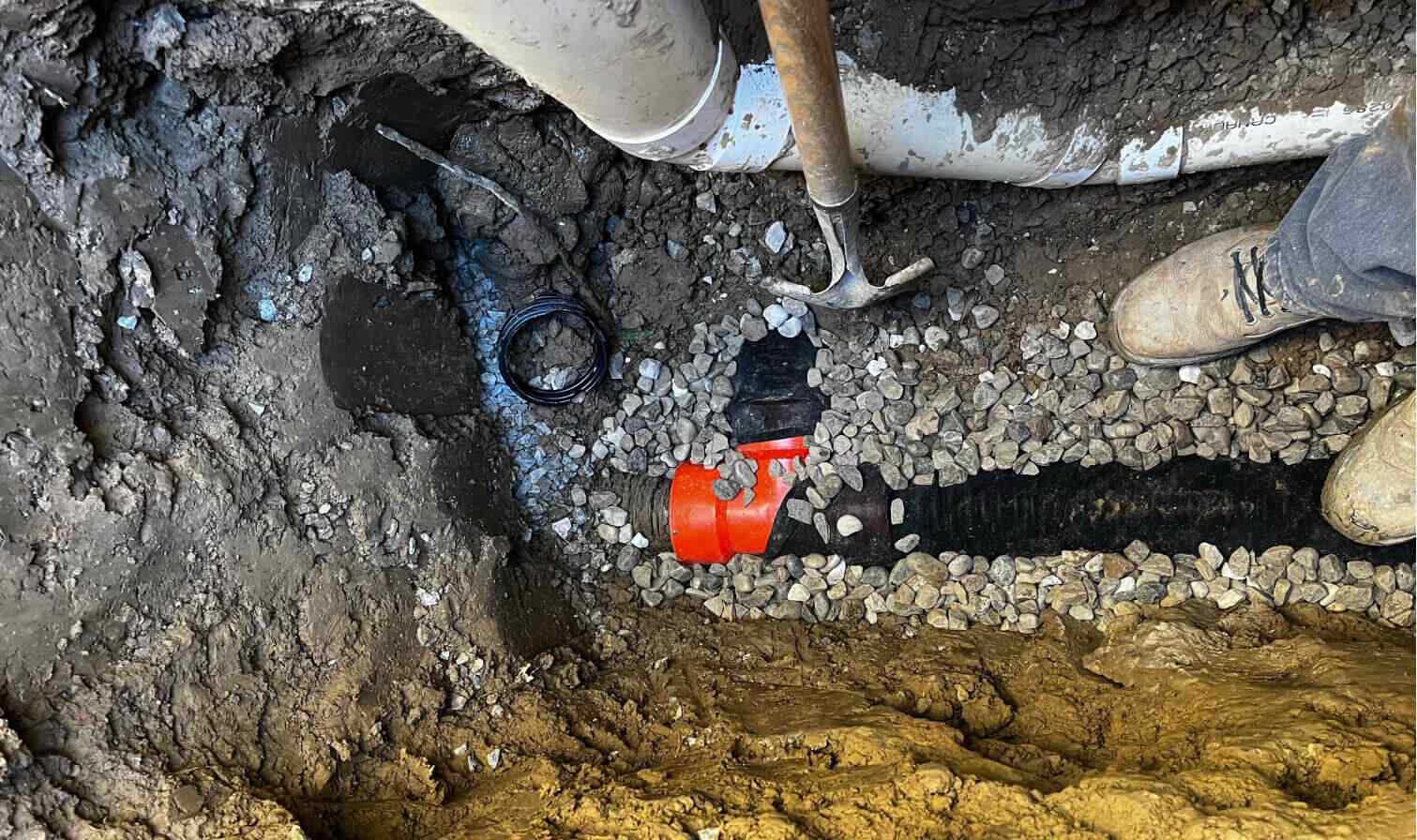Repair Footing Drains
Comfortable living is the dream of every homeowner. But the answer to the question “How to achieve this?” is not so easy to find. Foundation drainage collects and diverts groundwater from the base of the house, preventing it from accumulating. Its elements are a perforated pipe that collects water to divert it into a storm sewer, water collector, or special pit. Without reliable drainage, the foundation is in danger. This can cause flooding of the basement or underground space, as well as the entire house.
The most common problems with footing drains are the accumulation of fine soil particles or exposure to tree roots and other plants. It also often happens that the problem is in the pipes themselves if they were installed incorrectly, at the wrong angle, etc. Another reason for the failure of foundation drainage may be the occurrence of silt deposits provoked by an excess of iron in the soil.
Whatever the case, don’t panic! Superior Plumbing & Heating is ready to fulfill all your wishes. The main principles of our company:
- Any type of work is performed exclusively by professionals of the highest category;
- Our company employs only highly qualified specialists who have solid experience in providing plumbing repair services. They can perform work of any level of complexity;
- Use of high-quality materials and tools;
- The installation is carried out according to modern installation methods.
Contact Superior Plumbing for affordable repair footing drains. Our masters will do everything you need:
- Diagnose the problem using a CCTV drain camera;
- Determine a viable method for repairing or replacing foundation drainage;
- If necessary, remove all obstacles (tree roots, bushes, paving stones, etc.)
- Carry out the necessary excavations to get to the foundation;
- Install a perforated pipe around the foundation;
- Connect the drain and drainage pipe;
- Install a membrane to prevent clogging;
- They will check the drainage for breakages and install a waterproofing membrane to eliminate them.
How to quickly fix drainage problems?
As we said above, drainage in the foundation helps to divert water away from the foundation. It is a thick pipe in a layer of loose gravel, which will serve as a kind of sieve to keep dirt out. Usually, this design is installed during the construction of the house.
But unfortunately, unpleasant situations of clogging of drainage pipes often occur. Dirt and various debris get there, which eventually clogs the pipes and prevents the successful drainage of water. Later, leaks appear, followed by basement flooding. What to do in this case?
Drainage repair is associated with significant costs since there is a need to:
- dismantling of the blind area and tile covering of the local area;
- excavation of a significant amount of soil;
- cash costs for the purchase and installation of consumables.
But, in fact, rarely is this problem beyond repair. The first thing to start with is to try to find and clean the foundation drains. This is done in this way: first, you need to dig the ground near the building where the foundation drain is located and then open it up to clean it. You can also try to change the structure of the soil because if they are too loose, in rainy weather, it is saturated with a huge amount of water and can provoke leakage of the foundation drainage. And if this does not help, then you will have to dig up the base of the foundation for a full repair or partial replacement of pipes.
If you are not sure that you can handle the repair on your own, then our company is ready to help. The masters of Superior Plumbing & Heating will be able to help you repair your home’s drainage system and select drainage pipes of the right diameter and all the necessary connecting elements. Fix your foundation drainage problem today – contact us and get immediate help!
What are the features of using different types of foundation drainage?
Foundation drainage systems are of 3 types:
- French drainage;
- Foundation drainage;
- Sump Pits.
Let’s talk about types of foundation drainage in more detail:
- French drainage may not have French roots, but it can effectively resist flooding in your basement. When it’s damp and rainy outside, the loose soil outside your basement will absorb moisture. A considerable weight of water exerts pressure on the walls of the basement – this can be compared to ocean waves rocking a boat. If there is a lot of moisture, it accumulates under the basement floor. The technical name for this process is hydrostatic pressure. A waterproofing membrane helps to contain water pressure – a channel that diverts surface and groundwater from one area to another. Its main task is to help keep groundwater at a given level and divert it from the foundation. The disadvantage of the external French drainage system is that some basements can still be flooded.
- Foundation drainage is a complex solution that consists of external drainage and foundation waterproofing by intercepting, collecting, and draining groundwater. Installation of the wall drainage system is carried out from the outside of the building along its contour. The distance between the building wall and the drainage pipe depends on the design width of the foundation, as well as on the location of the manholes. If the foundation is at a considerable depth, then it is allowed to install drainage above the base of the foundation. Although foundation drainage is a simple and economical method, it is also the most inconvenient to use. It is unsafe to have a system of deep trenches on the site, even closed with strong shields or gratings.
- And the last way to protect yourself from sweat in the basement is sum pits. This is a waterproofing type structure which is intended to collect water. Usually, it is located under the house. When water enters there, the sensor controls its level, and the drainage pump, which is located inside this pit, pumps out the accumulated water through the pipes. This pump is usually electric. But with all the ease of implementation, the problem is that pumps are difficult to repair, they often make unpleasant sounds, and you also need a backup battery if there is no electricity.
What to do if there is a water leak through the concrete foundation?
You think that the foundation of your house does not let water through and will serve faithfully for many years, but it happens that the integrity of the foundation can be broken over time. Due to the freeze-thaw cycles of the soil and hydrostatic water pressure from within, foundation walls can change their geometry and crack, resulting in foundation leaks. This problem can affect any kind of foundation, no matter what it is made of. As a result, water leaks through the concrete foundation, which automatically leads to serious costs for the repair of the foundation.
When leaks appear in the foundation, this can lead to the following problems:
- shrinkage of the concrete foundation;
- accumulation of water near the walls of the basement or under the floor;
- drainage problem: the constant presence of water near the foundation;
- water leakage between the foundation masonry elements;
- blockage at the foundation drainage pipe.
To protect your home, it is better to deal with water leakage problems right away: solve them and thereby avoid further damage to the foundation. The company’s specialists will quickly and efficiently solve your problem and fix drainage problems:
- They will dig an observation trench close to the outer wall – in the place where the foundation is in contact with the ground;
- Find a place where moisture accumulates, usually near the foundation or under the floor;
- All cracks will be promptly eliminated;
- Perform a quality repair or replacement of the drainage system to divert surface water from the foundation.
How does footing drain installation help?
Excess groundwater leads to flooding of the house, erosion of useful wall layers, and prevents the efficient use of the entire territory of the site. To avoid this, you need a drainage system that will remove excess water.
To install it you need:
- Draw the proposed foundation drainage scheme;
- Check the proposed layout with all the slopes and levels around your house;
- Estimate the width, depth, and length of the trench;
- Dig a trench according to the drawing;
- Lay gravel or other filter material on the bottom of the trench;
- Install pipe;
- Connect this pipe to the sewer system or sump;
- Fill the trench with soil.
Foundation drainage is an integral part of a building, especially in areas where it rains and snows frequently. As practice shows, without the help of qualified masters, it is impossible to perform this kind of work qualitatively on your own. Whether it’s French, Foundation drainage, or Sump Pits, you can’t do without professionals. If you need footing drain installation, feel free to contact us. We are proud of:
- High-quality services;
- Fast response time;
- Our best specialists with many years of experience;
- Using of innovative equipment;
- Affordable prices.
One call to Superior Plumbing & Heating, and your problem is solved in no time!

 Call us and we’ll come to you
Call us and we’ll come to you 









